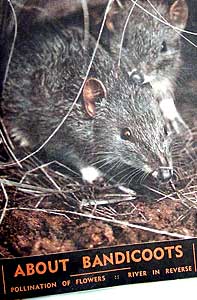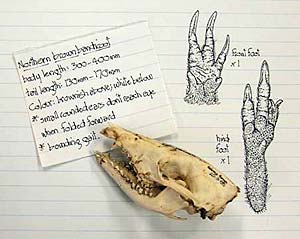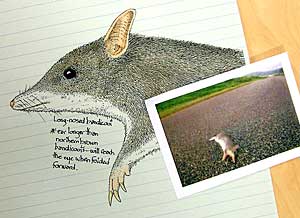About bandicoots
A quiet neighbour

Many people living on the fringe of bushland go about their lives unaware of the wildlife sharing their yards and gardens. But even though we rarely cross paths with these animals, they do leave clues. When the clue is a finger-deep, conical hole in the lawn or garden, the visitor is likely to be either a northern brown or maybe a long-nosed bandicoot. Like any quiet neighbour, bandicoots don’t usually attract friends or enemies. They only make themselves known when their diggings result in pockmarked lawns and unearthed vegetables. Even then, a bandicoot could either be seen as a pest or a pest controller — depending on what it eats and where it eats it.
This makes living with bandicoots a matter of give and take: balancing the benefits of a flawless backyard and garden with the knowledge that your property is part of the habitat of a native marsupial that may be helping to keep pests out of your lawn.
Understanding bandicoots

The best way to learn about bandicoots is to watch them. They’re very wary and rarely venture far from the safety of long grass or thick undergrowth. A few weeks of watching where bandicoot holes occur, and working out when the bandicoots are active, will improve the chances of being in the right place at the right time to see a bandicoot. Then it’s a matter of sitting quietly with a torch, and waiting. But even then you may not see one — if the bandicoot sees you first. Unfortunately, most bandicoots are seen when it’s too late — after they’ve been killed on the road or by cats or dogs. This is a reminder that we often have greater impacts on wildlife than they have on us.
Finding a dead bandicoot also provides a rare chance to look at one closely. When having a close look at a bandicoot it is useful to remember that they pick up parasitic ticks (including paralysis ticks) as they move through the undergrowth. These ticks can also attach themselves to humans and pets. If not removed, paralysis ticks can kill cats and dogs and cause severe reactions in humans — particularly children. Bandicoots are just one of the small mammals that play host to ticks and are not responsible for ‘tick plagues’.
Bandicoots are designed to eat underground food, although they won’t go past insects and even berries found on the ground. With a sensitive nose they can readily sniff out insects, worms, roots and even fungi. Once a food item is located, they scoop out a conical hole with the rake-like claws on their front feet. The long, pointed face probes the bottom of the hole and any food is quickly pinched out between fine, needle-like teeth.
A common food for bandicoots living near suburban areas is the larva of scarab beetles (commonly known as ‘lawn grubs’). These grubs feed on grass roots and kill patches of lawn. They emerge in summer as leaf-eating beetles like the ‘Christmas beetle’. By eating these grubs, bandicoots actually protect lawns and reduce the number of beetles that can later cause problems by defoliating gum trees. With their heads stuck in the ground, bandicoots can be at risk from unseen domestic cats and dogs. Large, mobile ears positioned well back on the bandicoot’s head keep them aware of what’s going on around them. Northern brown and long-nosed bandicoots mainly give birth from late winter to the following autumn but will breed throughout the year. This would coincide with the times when scarab beetles and other insects are available in their underground larval stage.
Being a marsupial, the females have a pouch and give birth after a very short pregnancy of a little over twelve days. A week before the young are born they are little more than a clump of cells. At birth they look more like baked beans than bandicoots, still attached to the mother by individual umbilical cords. The northern brown bandicoot usually has two to four young, while the long-nosed bandicoot usually has two to three.
After 60 days the young are independent adults and can breed before they are six months old. Very short pregnancies are a trait of all marsupials. This is an efficient way of producing young quickly when food is abundant.
Living with bandicoots

Having bandicoots as neighbours means a number of things.
They are living proof that residential areas can help meet the habitat needs of small native mammals. If bandicoots are seen regularly (including young ones) then it also indicates that the local population is not threatened by predation from domestic cats and dogs or at risk from having to cross roads — another plus for other local small mammals. From the other side of the fence, bandicoots will make holes in lawns and gardens. This is a problem if property owners value their lawns and gardens intact above the lawn grub removal services provided by bandicoots. What action is then taken is guided by whether a bandicoot is seen as a problem or a reminder that wildlife on your land can work for you by keeping a range of insect pests in check.
If you want bandicoots to be ‘people-friendly’
Keep the bandicoot out of places where you don’t want it to be. Put chicken wire around or over vegetable gardens. The wire should be at least 500 mm high and be dug into the soil to a depth of 150 mm. Lawn grubs can be killed by spraying so that lawns are no longer seen as feeding sites. Seek advice from a plant nursery before choosing a spray to ensure that it doesn’t affect the bandicoots and other animals that might feed on the lawn grubs. Give bandicoots something else to eat, away from gardens and lawns. If you want your garden and bandicoots too, a solution may be to have an open compost heap or an area of thick mulch where bandicoots can go to feed. By combining this with garden fencing and lawn grub control you can get the best out of your garden and lawn while bandicoots feed somewhere else.
If you want to be ‘bandicoot-friendly’
If bandicoot holes in the lawn are not a problem — or the problem is outweighed by the benefits of their natural lawn grub control and their ability to aerate the soil — then you may want to let bandicoots be bandicoots. The simple solution is to keep an old watering can full of river sand or friable soil on hand and just top up any holes as they appear. This will keep your lawn level and help to aerate your soil.
Having bandicoots around can also be interesting. Over time, you learn more about their behaviours and life histories. You can follow their lives from weaning to when they have their own young. Individual bandicoots can sometimes be identified by distinguishing marks like scars, notched ears or missing tails. Even their behaviours may vary enough so that you can tell one from another.
Over time, you will see bandicoots become adults, come and go, suffer injuries and disease, and eventually die. If bandicoots are regularly seen (including young ones) then it indicates that the local population is probably stable. If you are finding dead bandicoots, you may be able to help limit this by keeping your cat in at night or driving slowly in places where you’ve seen road kills. If you own a pool, make a ‘wildlife ramp’ out of a piece of wood so that bandicoots and other animals that accidentally fall in can climb out again. Studying your local bandicoots can be a fascinating way to learn about how they live.
When all else fails
If you want the bandicoots removed it is important to remember that they are protected. They can only be removed with the permission of the department if they are identified as a major problem. However, bandicoots are territorial and only appear in higher numbers when their young are almost independent. These young soon disperse and the problem literally goes away. If a bandicoot is removed, another bandicoot will probably take its place. Similarly, if a bandicoot is relocated, it then has to find a new and unoccupied territory if it is to survive. In most cases a relocated bandicoot will either displace a resident bandicoot from its territory or remain a vagrant. Either way, one bandicoot will be without a territory and be exposed to greater risks of predation and stress.
And what if the bandicoots just disappear?
As people place more demand on land, the wildlife living there can just slip away unnoticed and quickly become forgotten. Many areas that were bushland where bandicoots once lived are now cleared. Being mammals that live on the ground, bandicoots are one of the first native animals to disappear when bushland becomes fragmented, the undergrowth is removed and domestic and feral predators are introduced. Bandicoots are an indicator species that shows that an area is likely to be home to a range of other species with similar needs to their own, or are linked to them through food chains as predators, prey or even decomposers. Where bandicoots still live alongside residential areas it shows that these properties can be part of a healthy ecosystem. Maybe living with a ‘bandicoot problem’ is not a problem after all but just a sign that you live a little bit closer to nature than you realised. And by living with these quiet neighbours, you are playing a role in keeping a larger wildlife community intact.
Sick, injured or orphaned animals
If you happen to come across a sick, injured or orphaned native animal, please contact the RSPCA Qld. Further information about what you can do if you come across a sick, injured or orphaned native animal is available on the departmental website.